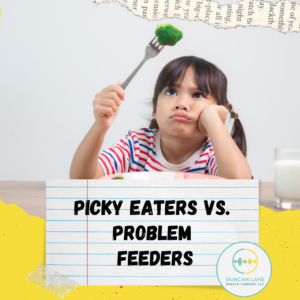As parents, it’s common to worry when your child seems to have a limited diet or refuses to eat certain foods – AKA picky eating! While some kids are simply “picky eaters,” others may be dealing with deeper challenges. So, how can you tell if your child is just picky or if they’re facing more significant feeding difficulties? Let’s break it down!
Picky Eaters
Picky eaters often have a reduced variety of foods they’ll eat but are still able to consume more than 30 different types. They may go through phases where they stop eating foods they used to enjoy, but after some time, they often come back around. These children typically eat at least one food from most textures or nutritional groups and can tolerate new foods on their plate, even if they are hesitant to try them.
Parents of picky eaters sometimes note that their child may eat different foods than the rest of the family, but still eat together. Additionally, picky eating is often a temporary phase, lasting less than two years.
Problem Feeders
Problem feeders, on the other hand, tend to have a much more restricted diet—eating fewer than 20 different foods. Once they stop eating a particular food, it’s usually for good. These children often refuse entire categories of food textures or nutrition groups, and introducing new foods can lead to complete meltdowns.
Problem feeders may always need to eat separately from the family or at a different time. If a child has been reported as a “picky eater” for more than two years, they may actually be a problem feeder in need of more support.

Why does this matter?
Research shows that 1 in 5 children will struggle with eating at some point by the time they turn seven. While half of these children may outgrow their feeding issues, the other half won’t—without intervention. That’s where feeding therapy comes in.
Because feeding difficulties can be so personal and emotional for children, it’s important to find a therapist that specializes in addressing the root causes of feeding challenges. Whether your child is a picky eater or a problem feeder, therapy can give both you and your child the tools to make mealtime more enjoyable. The goal is to help your child expand their diet, reduce mealtime stress, and ultimately develop a healthier relationship with food.
When is it time to get help?
If you notice that your child has been struggling with eating for more than two years or consistently shows signs of distress when presented with new foods, it may be time to seek professional support. Early intervention can make all the difference in ensuring your child’s feeding challenges don’t become long-term obstacles.
Don’t wait until mealtime becomes a battle. Contact us today to learn more about how feeding therapy can help your child develop the skills they need to enjoy a more varied and nutritious diet.



Recent Comments